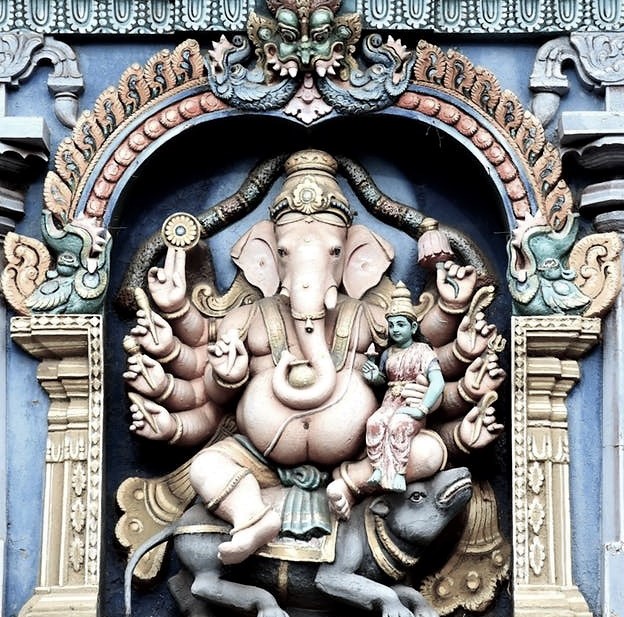- Special FeaturesFoundation YearStone inscriptions in the temple date it back to the Second Chera Empire (800 - 1102 AD)Sthala TreeTheerthamRathamArchitectureDravidian architectureOther Speciality(Divya Desam)
- Sthala Puran
The Thrichittatt Mahavishnu Temple (also called Thiruchenkundrur and Imayavarappan temple) is a Hindu temple dedicated to Supreme God Vishnu and located in Chengannur, Alappuzha District, Kerala, South India.
It is one of the five ancient shrines in the Chengannur area of Kerala, connected with the legend of Mahabharata. Legend has it that the Pandava princes, after crowning Parikshit as king of Hastinapura left on a pilgrimage. On arriving on the banks of river Pamba, each one is believed to have installed a tutelary image of Krishna; Thrichittatt Maha Vishnu Temple by Yudhishthira, Puliyur Mahavishnu Temple by Bheema, Aranmula Parthasarathy Temple by Arjuna, Thiruvanvandoor Mahavishnu Temple by Nakula and Thrikodithanam Mahavishnu Temple by Sahadeva.
During Mahabharata war, Yudhishthira, the head of the Pandavas, who never before uttered a lie, lied in one instant to defeat his Guru, Dronacharya. To overcome the sin of the lie, he underwent penance worshiping the lord here. Imayavar (Devas) came to this place prior to Yudhishthira and hence the deity here is referred as Imayavarappar. There is another version that the Pandavas worshipped the idols during the reign and started installing them in different places during the end of the reign.
Thiruchittattu temple, is considered to be one among the 108 most sacred place of worship, where Lord Vishnu himself resides.
The Temple is believed to have been built by Devas along the banks of Chittar, a tributary of Holy River Pampa, before mankind was born. The temple, was then renovated, by Yudhishthira in Dvapara Yuga. The temple is considered to be the primary temple among the five Mahavishnu Temples built by Pandavas.
It is believed that long before Yudhishthira renovated the temple, the Devas undertook pilgrimages to this spot many a time for the purpose of making special prayers and requests to the Lord to bless them so that they can ensure that the objective of harmony between the three world is fulfilled
After their prayers Lord Vishnu, presented himself to bless the Devas and also for them to get a glimpse of the Lord, filling the devotees with a sense of joy and wiping of their sorrows
In Dvapara Yuga, the Pandavas resided at present day Chengannur for a large duration of their exile, hence, after the passing of Lord Krishna, Sage Brighu persuaded the Pandavas to consecrate four sacred temples in the vicinity, to the Lord, who was their guide and protector in Mahabharata
This, would allow daily offerings and pooja to be carried out on the benevolent Lord, in the form of the Thevaram, not only by Pandavas but also all the people who helped Pandavas survive during the exile. The Pandavas, maintained and performed Pooja in the five temples till their Swargarohanam (Auspicious journey to Vaikuntam)
Yudhishthira on renovation of the temple, installed the Thevara Moorthy of Lord Vishnu with a tutelary image of Lord Krishna. This unique idol, is facing east in a standing posture, with four arms, holding the - Shankh (Conch) in the upper right hand, Sudharshana Chakra (Discus) in the upper left hand, Lotus in the lower right hand. The lower left hand is free, however Lord Vishnu idols generally have a Gada (Mace) in this hand.
Yudhishthira after having a holy bath, installed the idols after immersing it in the Pushkarani (Pond), filling the Conch with its water and performed the first Pooja after installation
Hence, the pond at Thrichittat is named as - Amurtha Pushkarani, since the idol was immersed in it and as - Shankh Theertham, on the occasion of the pond's water filling the Conch, therefore, worshipping at Shankh Theertham, is considered equivalent to that of Sree Kovil (Sanctum Sanctorum of the Temple), and full darshanam is complete when both places are worshipped
- Architecture
The temple is built in Kerala style architecture, common in all temples in the South Indian state of Kerala in Eastern axis. The temple has no gateway tower and has an arch from the main road. A rectangular wall around the temple, called Kshetra-Madilluka pierced by the gateways, encloses all the shrines of the temple. The metal plated flagpost or Dwajasthambam is located axial to the temple tower leading to the central sanctum. Chuttuambalam is the outer pavilion within the temple walls. The central shrine and the associated hall is located in a rectangular structure called Nallambalam, which has pillared halls and corridors. Between the entrance of Nallambalam to the sanctum, there is a raised square platform called Namaskara Mandapa which has a pyramidal roof. Thevrapura, the kitchen used to cook offering to the deity is located on the left of Namaskara Mandapa from the entrance. Balithara is an altar is used for making ritualistic offering to demi-gods and the festive deities. The central shrine called Sreekovil houses the image of the presiding deity. It is on an elevated platform with a single door reached through five steps. As per Kerala rituals, only the main priest called Thantri and the second priest called Melshanthi alone can enter the Sree Kovil. The central shrine has a circular plan with the base built of granite, superstructure built of laterite and conical roof made of terrocata tile supported from inside by a wooden structure. The image of the presiding deity is 4 ft (1.2 m) tall. Krishna is in Vishvarupa pose, the one he depicted to Arjuna during the Mahabharatha war. In the second precinct, there are shrines of Sastha, Yakshi, Nagaraja and Erangavil Bhagavathy Balarama in the lower shrine.
- Alankar of Deity
- Prayers and BenefitsSpecial Vratas and PrayersOfferings to DeityStotras and Mantras
- Festivals
- Sodasha Upcharas
- Prasadhas
- Social ActivitiesAnnadhanMarriageEar BoringHead ShaveDanaasEducation FacilitiesSocial DrivesOther Activities
- Arjita Seva
- Tags

